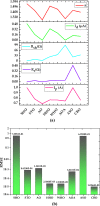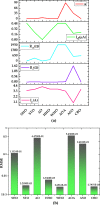Performance investigation of state-of-the-art metaheuristic techniques for parameter extraction of solar cells/module
- PMID: 37429876
- PMCID: PMC10333343
- DOI: 10.1038/s41598-023-37824-4
Performance investigation of state-of-the-art metaheuristic techniques for parameter extraction of solar cells/module
Abstract
One of the greatest challenges for widespread utilization of solar energy is the low conversion efficiency, motivating the needs of developing more innovative approaches to improve the design of solar energy conversion equipment. Solar cell is the fundamental component of a photovoltaic (PV) system. Solar cell's precise modelling and estimation of its parameters are of paramount importance for the simulation, design, and control of PV system to achieve optimal performances. It is nontrivial to estimate the unknown parameters of solar cell due to the nonlinearity and multimodality of search space. Conventional optimization methods tend to suffer from numerous drawbacks such as a tendency to be trapped in some local optima when solving this challenging problem. This paper aims to investigate the performance of eight state-of-the-art metaheuristic algorithms (MAs) to solve the solar cell parameter estimation problem on four case studies constituting of four different types of PV systems: R.T.C. France solar cell, LSM20 PV module, Solarex MSX-60 PV module, and SS2018P PV module. These four cell/modules are built using different technologies. The simulation results clearly indicate that the Coot-Bird Optimization technique obtains the minimum RMSE values of 1.0264E-05 and 1.8694E-03 for the R.T.C. France solar cell and the LSM20 PV module, respectively, while the wild horse optimizer outperforms in the case of the Solarex MSX-60 and SS2018 PV modules and gives the lowest value of RMSE as 2.6961E-03 and 4.7571E-05, respectively. Furthermore, the performances of all eight selected MAs are assessed by employing two non-parametric tests known as Friedman ranking and Wilcoxon rank-sum test. A full description is also provided, enabling the readers to understand the capability of each selected MA in improving the solar cell modelling that can enhance its energy conversion efficiency. Referring to the results obtained, some thoughts and suggestions for further improvements are provided in the conclusion section.
© 2023. The Author(s).
Conflict of interest statement
The authors declare no competing interests.
Figures































References
-
- Lim WM. The sustainability pyramid: A hierarchical approach to greater sustainability and the United Nations sustainable development goals with implications for marketing theory, practice, and public policy. Australas. Mark. J. 2022;30(2):142–150. doi: 10.1177/18393349211069152. - DOI
-
- Beck, J. V. and Arnold, K. J. Parameter estimation in engineering and science: (James Beck, 1977).
-
- Krishan O, Suhag S. An updated review of energy storage systems: Classification and applications in distributed generation power systems incorporating renewable energy resources. Int. J. Energy Res. 2019;43(12):6171–6210. doi: 10.1002/er.4285. - DOI
-
- Naeijian M, et al. Parameter estimation of PV solar cells and modules using Whippy Harris Hawks optimization algorithm. Energy Rep. 2021;7:4047–4063. doi: 10.1016/j.egyr.2021.06.085. - DOI
LinkOut - more resources
Full Text Sources

